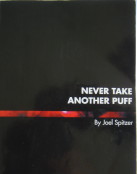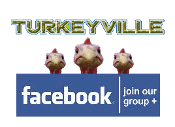Patient Nicotine Dependency Recovery Resources for Medical Professionals
- Free patient quitting books and handouts
- 100+ original quit smoking articles
- 500 free video lessons
- Scores of empowering motivational pages
- Peer support at Turkeyville, a 13,000+ member Facebook group
Health care professionals know that quitting smoking may be the single greatest factor toward improving a patient's overall health and quality of life. But when alerting patients to existing tobacco related health problems, or the long-term consequences of smoking, far too often the provider's warnings go unheeded. When coupled with extremely high relapse rates among patients who do attempt, the endless cycle of frustration can condition health care professionals to simply stop trying to motivate cessation.
Reality is, adequately armed, a trusted medical professional, you remain perfectly positioned to make a major difference.
How to help your smoking patients quit smoking
While health professionals know the benefits of smoking cessation they are not always informed or trained on successful interventions. Many providers have been sold on believing that alternate nicotine delivery vehicles such as the over-the-counter nicotine gum, patch, lozenge are state-of-the-art treatment strategies. Yet, after 30 years and billions spent marketing Nicorette, a 2013 Gallup Poll found that nicotine gum accounted for only 1% of all successful ex-smokers, that most quit cold turkey.
While demonstrating almost two-fold efficacy in clinical trials, trials we now know were not blind as claimed, to date, in nearly all real-world settings, pharmacology has proven ineffective as a treatment strategy. As WhyQuit's founder noted in a November 2008 CMAJ letter, "pharmacologic treatment of chemical dependency may be the only known research area in which blinding is impossible."
Physicians were first alerted to population level NRT concerns by a 2002 JAMA study, which concluded that "NRT appears no longer effective in increasing long-term successful cessation in California smokers."
Since then, a steady stream of real-world quitting method findings have cast doubt on the effectiveness of any product which calls for weeks or months of continued dopamine pathway stimulation, before the patient is told to end use and attempt to adjust to natural stimulation.
While approved products clobber placebo inside randomized clinical trials, approved products are clobbered just as badly by cold turkey in population level quitting. Doran 2006 followed the smoking patients of 1,000 Australian family practice physicians. Not only did cold turkey roughly double NRT and Zyban quitting rates, it accounted for 92% of all successful ex-smokers.
Even a June 2009 GlaxoSmithKline study by the maker of Nicorette gum and Zyban was forced to report that its own quitting survey found that cold turkey quitters trounced those using approved quitting products.
Medical professionals have seen a rash of recent population level studies find approved products ineffective (see Pierce 2012, Alpert 2012, Ferguson 2012, Hartman 2006 [see PDF pages 34,35 & 36], Doran 2006 and Alberg 2005).
These studies are motivating a return to cold turkey. In January 2020 the U.S. Surgon General acknowledged a growing body of data indicating "that most smokers who quit successfully do so without medications or any type of formal assistance" and that "cold-turkey quitters do as well or better than those who use over-the-counter NRTs."
This stream of population ineffectiveness evidence raises an obvious concern. If approved quitting products undercut the patient's ability to quit, with smoking claiming half of adult smokers, are these products ultimately costing patients their lives?
Even the pharma industry's population findings are troubling. A March 2003 meta-analysis by GSK consultants found that 93% of patients using over-the-counter NRT products relapsed to smoking within six-months. And the same GSK consultants reported in November of 2003 that 36.6% of Nicorette gum quitters became persistent long-term users of at least 6 months.
Pfizer's varenicline approval studies (Chantix and Champix) were engineered to make headlines. The studies were clearly not blind as claimed, excluded nearly 30% of applicants reflecting the most challenging quitting populations, were inflated by sixteen one-on-one counseling sessions and eight provider telephone calls, raised 165 potential side-effect concerns, including suicide, and, amazingly, were so sloppy that researchers allowed NRT use between the end of the 12-week treatment period and one-year follow-up, without documenting NRT's impact upon outcome.
To date, there have only been two randomized clinical trials pitting Chantix against NRT, Aubin 2008 and Tsukahara 2010. In both, Chantix failed to show statistical significance over nicotine patch when assessing the percentage of users within each group who were not smoking at 24 weeks.
No matter how much or how long a patient has smoked nicotine they need to understand that the possibility of quitting exists for them. The self-help resources and materials reviewed below can aid health care providers in helping patients quit smoking or end dependence upon other forms of nicotine delivery.
Totally free, consider recommending WhyQuit.com
Whether WhyQuit's free motivation, education and support resources are printed and shared as patient office handouts, sampled in the patient waiting area or their existence and availability is simply brought to the patient's attention, given an opportunity these materials have the potential to make a significant difference over what you've previously experienced.

Motivation
Nicotine dependent patients who try quitting and fail generally attribute relapse to a lack of strength or willpower. In reality, their inability to quit is more likely due to a lack of understanding of how to quit. WhyQuit.com provides patients the information and understanding needed to successfully stop smoking, vaping, or using oral nicotine products and remain free.
WhyQuit was founded in July 1999 by John R. Polito, a once hopelessly addicted 30-year, three pack-a-day smoker.  John is the 2009 author of "Freedom from Nicotine - The Journey Home." Documenting the science underlying abrupt nicotine cessation, it's the only quitting book cited by the Surgeon General in his 700 page Janunary 2020 Smoking Cessation Report. It provides a roadmap through the four layers of recovery (physical, emotional, subconscious re-conditioning, and conscious fixation) while providing readers insights in how to minimize the effects and impact of each. It's available as a free PDF e-book that can be printed or burned to a disk and given to patients.
John is the 2009 author of "Freedom from Nicotine - The Journey Home." Documenting the science underlying abrupt nicotine cessation, it's the only quitting book cited by the Surgeon General in his 700 page Janunary 2020 Smoking Cessation Report. It provides a roadmap through the four layers of recovery (physical, emotional, subconscious re-conditioning, and conscious fixation) while providing readers insights in how to minimize the effects and impact of each. It's available as a free PDF e-book that can be printed or burned to a disk and given to patients.
WhyQuit was originally a motivational site whose primary objective was to provide a potent sampling of the hazards of smoking. Over the years it evolved into what you see today, a content rich site providing motivation, education and support for any patient who dreams of breaking nicotine's grip upon their mind, health and life. While your guidance is needed to prime patients into wanting to arrest their chemical dependency and in motivating them to visit and explore WhyQuit, the site stands ready to educate, support and provide additional motivation upon arrival.
WhyQuit introduces patients to the concerns of the cardiologist, pharmacologist, and radiation oncologist. It provides them a list of tobacco's 81 known carcinogens and shares tragic stories of their impact upon young victims such as Bryan, Noni, Sean, Kim, Gruen and Deborah. Patients review the scope of smoking's self-inflicted bodily destruction, contrast risks of common causes of death, are introduced to a list of famous victims under age 60 and watch scores of thought provoking video clips.
Patients learn how nicotine enslaves the brain's dopamine reward pathways, how the tobacco industry has long known that nicotine is the sine qua non of smoking, the timetable for recovery and the symptoms they might encounter. The also learn that WhyQuit is home to the Internet's largest library of original quitting articles (Joel's Library) and its most focused peer support forum, Turkeyville.
Education
The American Cancer Society's Cancer Facts & Figures 2003 report indicates that 91.4% of all successful long-term quitters quit entirely on their own without pharmacology products such as nicotine gum, patch, lozenge, spray, inhaler, bupropion (Zyban/Wellbutrin) or varenicline (Chantix/Champix) and without hypnosis, acupuncture, lasers or scopolamine injections. We've designed our site to help smokers understand that they too can follow their natural instincts and implement this extremely productive approach.
How to quit smoking
Nearly 500 additional recovery videos
Joel's Library is WhyQuit's education cornerstone. Joel Spitzer began developing and conducting smoking prevention and cessation programs in 1972. His programs were designed to help quitters understand why people smoke, why they should stop, how to quit, and most importantly how to stay quit. His library's 100+ reinforcement articles present smoking and nicotine as a true chemical dependency. Indexed under seven topics - dependency, health risks, quitting, relapse prevention, weight control, youth prevention, and history - each article in the collection is united by the underlying theme that to get off and stay off of cigarettes the smoker must learn to "Never Take Another Puff."
A quick sampling of the library shows how Joel addresses the cessation blood-sugar swing issue, the emotional loss associated with quitting, sleep adjustments, fixating, anger, quitting crutches, "cheating," and the important issue of cessation weight gain.
Joel's "My Cigarette My Friend" has become a staple in cessation programs around the globe. It's an excellent ice-breaking article to print and keep available in your patient waiting area (single-page PDF for printing and sharing).
 Joel's Library is also home to his free e-book that you can download and print for patients who don't have Internet access. Entitled "Never Take Another Puff" it is Joel's Library in .PDF book format (1.32MB - 149 pages) and makes a perfect gift for smoking patients. Our only request is that our materials be made as freely available to patients as we have made them to you, without any cost or charge.
Joel's Library is also home to his free e-book that you can download and print for patients who don't have Internet access. Entitled "Never Take Another Puff" it is Joel's Library in .PDF book format (1.32MB - 149 pages) and makes a perfect gift for smoking patients. Our only request is that our materials be made as freely available to patients as we have made them to you, without any cost or charge.
Joel's Library is home to nearly 500 Video Quit Smoking Lessons, with many in audio format. You are encouraged to burn and share your own disks, allowing smoking patients to leave the office with counseling sessions in hand. Again, our only request is that these lessons be made freely available without charge or cost.

Serious Group Support
WhyQuit's newest support group is Turkeyville, a Facebook group. Here, more than 13,000 members contribute to a fast moving message wall where the primary focus remains educating and supporting new quitters in a nicotine-free environment.
Please rest assured that Turkeyville has strictly enforced policies against any member rendering medical advice regarding any symptom described on the message board. The forums' Courtesies and Rules expressly forbid members from rendering advice or making any recommendations regarding specific health concerns, answering member medication or herb concerns, or from making dieting recommendations. Instead members are strongly encouraged to seek the assistance of qualified professionals.
Knowledge is a Quitting Method
